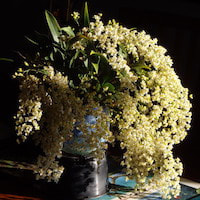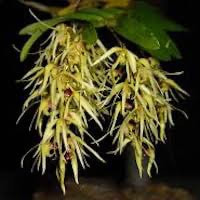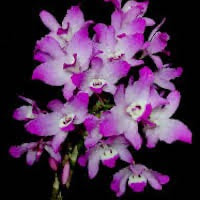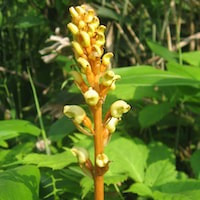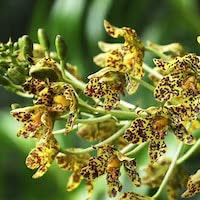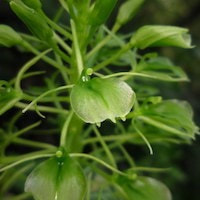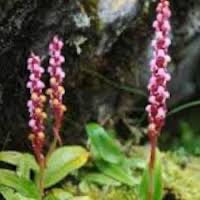Experience the Tranquil Woody Essence of Women Fragrance Oil Woody 5
The fragrance composition features scented notes from various orchid species, each contributing its unique characteristics to the overall scent. One of these notes is Oncidium Twinkle, a native Singaporean orchid known for its easy growth, compact size, and profuse flowering in a range of colors. This orchid adds a strong woody and slightly spicy vanilla scent to the fragrance.
Another orchid note is Dendrobium denudans D. Don, which blooms with a striped lip during August and September. The pseudobulbs of this orchid are utilized as a remedy for fever and body aches in Darjeeling Himalaya, either eaten raw or used in the preparation of a narcotic remedy.
Dendrobium linawianum Rchb. f., a small to medium-sized orchid species found in Wulai, Taiwan, contributes its unique scent and herbal properties to the fragrance. It is known for nourishing the yin elements, benefiting the stomach, and providing relief from symptoms such as dry mouth, weakness, and joint pain.
The fragrance also includes scented notes from the genus Gastrodia R. Br., which comprises achlorophyllous, parasitic orchids. These orchids lack green leaves and derive their nutrients from a mold on the forest floor. Gastrodia elata, a species from this genus, has been traditionally used in Chinese medicine for its health-promoting and longevity-enhancing properties.
Grammatophyllum scriptum (L.) Blume, also known as Leopard Orchid or Tiger Orchid, contributes to the fragrance with its distinct scent and herbal benefits. This orchid has been employed in various herbal remedies, including the treatment of bacterial infections, thrush, and abdominal ailments. Its pulp and sap are utilized in poultices and mouth rinses, respectively.
Liparis cordifolia Hook. f. Syn. Liparis argentopunctata Aver., Liparis keitaoensis Hayata, commonly known as the Silver cricket orchid, imparts its unique aroma to the fragrance. This orchid contains alkaloids such as keitaonine and keitine, and its root decoction is used in Taiwanese traditional medicine to alleviate abdominal pain.
Satyrium nepalense D. Don var. nepalense, a common orchid found in several regions including Myanmar, Sikkim, Nepal, Bhutan, and Pakistan, contributes its distinct scent and medicinal properties. The tubers of this orchid are consumed to treat malaria, dysentery, and as an aphrodisiac, and they are considered a tonic.
To complete the fragrance composition, additional scent notes of wild dry grasses, birch, teak, balambra, papurus, rosewood, and olive are incorporated, adding depth and complexity to the overall scent profile.
Another orchid note is Dendrobium denudans D. Don, which blooms with a striped lip during August and September. The pseudobulbs of this orchid are utilized as a remedy for fever and body aches in Darjeeling Himalaya, either eaten raw or used in the preparation of a narcotic remedy.
Dendrobium linawianum Rchb. f., a small to medium-sized orchid species found in Wulai, Taiwan, contributes its unique scent and herbal properties to the fragrance. It is known for nourishing the yin elements, benefiting the stomach, and providing relief from symptoms such as dry mouth, weakness, and joint pain.
The fragrance also includes scented notes from the genus Gastrodia R. Br., which comprises achlorophyllous, parasitic orchids. These orchids lack green leaves and derive their nutrients from a mold on the forest floor. Gastrodia elata, a species from this genus, has been traditionally used in Chinese medicine for its health-promoting and longevity-enhancing properties.
Grammatophyllum scriptum (L.) Blume, also known as Leopard Orchid or Tiger Orchid, contributes to the fragrance with its distinct scent and herbal benefits. This orchid has been employed in various herbal remedies, including the treatment of bacterial infections, thrush, and abdominal ailments. Its pulp and sap are utilized in poultices and mouth rinses, respectively.
Liparis cordifolia Hook. f. Syn. Liparis argentopunctata Aver., Liparis keitaoensis Hayata, commonly known as the Silver cricket orchid, imparts its unique aroma to the fragrance. This orchid contains alkaloids such as keitaonine and keitine, and its root decoction is used in Taiwanese traditional medicine to alleviate abdominal pain.
Satyrium nepalense D. Don var. nepalense, a common orchid found in several regions including Myanmar, Sikkim, Nepal, Bhutan, and Pakistan, contributes its distinct scent and medicinal properties. The tubers of this orchid are consumed to treat malaria, dysentery, and as an aphrodisiac, and they are considered a tonic.
To complete the fragrance composition, additional scent notes of wild dry grasses, birch, teak, balambra, papurus, rosewood, and olive are incorporated, adding depth and complexity to the overall scent profile.
Download the guided mediation that works best with this Orchid fragrance oil
| women_woody_essential_oil_orchi_00005.mp3 | |
| File Size: | 163884 kb |
| File Type: | mp3 |
Discover the Orchid's Healing Touch: A Fragrance for Women
Contains Scented Notes of following in various proportions:
Native Singaporean Orchid notes: Oncidium Twinkle
|
Oncidium Twinkle - Used in Woody 5 (Women) for Team building Perfume workshop
Oncidium Twinkle is a popular orchid variety that is used in the fragrance "Woody 5 (Women)" for a team-building perfume workshop. It is considered one of the greatest miniature Oncidiums due to its exceptional qualities. This orchid is known for being easy to grow, with compact growth and a profusion of flowers. It is relatively disease-free, making it a favorable choice for both experienced and novice orchid enthusiasts. In terms of scent, Oncidium Twinkle emits a strong woody aroma with hints of spicy vanilla. This combination of scents adds depth and character to the fragrance, creating an intriguing olfactory experience. |
Therapeutic Orchid notes:
|
Dendrobium denudans D. Don
Dendrobium denudans, also known as D. Don, is an orchid species characterized by its purple-striped lip. It typically blooms during the months of August to September. In addition to its ornamental value, Dendrobium denudans has traditional herbal uses. In the Darjeeling Himalaya region, the pseudobulbs of this orchid are consumed raw to treat fever and alleviate body aches. Furthermore, these pseudobulbs are utilized in the preparation of a narcotic remedy. It's worth noting that the medicinal usage mentioned is based on traditional practices and should be approached with caution, as the efficacy and safety of such applications may vary. Consulting with a qualified healthcare professional is recommended before using any plant material for therapeutic purposes. |
|
Dendrobium linawianum Rchb. f.
Chinese names: Yinshihu (oriental cherry Dendrobium), Jinshihu (gold Dendrobium), Lishishihu (Mr. Lee’s Dendrobium), Juchunshihu (lip Dendrobium) Dendrobium linawianum is a small to medium-sized species with a confined distribu- tion being found only in Wulai in broad-leaved forests, at low altitude, in the mountainous north of the Taiwanese island. Dendrobium linawianum, commonly known as Yinshihu (oriental cherry Dendrobium), Jinshihu (gold Dendrobium), Lishishihu (Mr. Lee's Dendrobium), or Juchunshihu (lip Dendrobium) in Chinese, is a small to medium-sized orchid species. It has a limited distribution and is primarily found in Wulai, a region characterized by broad-leaved forests and low altitudes in the mountainous north of Taiwan. In addition to its ornamental value, Dendrobium linawianum is also used for its medicinal properties. In traditional herbal usage, the stem of this orchid is believed to nourish the yin elements and benefit the stomach. It is known to help alleviate symptoms such as thirst, feeling of heat, dry mouth, weakness, poor health, night sweats, and joint pain. It's important to note that the herbal usage mentioned is based on traditional practices and cultural beliefs. As with any herbal remedy, it is advisable to consult with a qualified healthcare professional before using Dendrobium linawianum or any other plant material for therapeutic purposes. |
|
Genus: Gastrodia R. Br.
Chinese name: Tianma Japanese name: Oni No Yagara Gastrodia is a genus of achlorophyllous, parasitic orchids. These plants lack green leaves and derive their nutrients from a mold that grows on the forest floor. The tubers of Gastrodia species are irregular in shape, somewhat ovoid, resembling a stomach (hence the name "gastro" from Greek), and are found underground. In Chinese tradition, it is believed that around 5000 years ago, during the early stages of civilization, Shen Nong, a legendary figure known as the "Divine Farmer," taught people how to cultivate crops and utilize various herbs for healing and promoting health and longevity. Among the plants mentioned is Tianma (Gastrodia elata). In a World Health Organization (WHO) publication on medicinal plants in Korea, Gastrodia elata is the only orchid species listed among 150 medicinal plants. It's worth noting that the traditional use of Gastrodia species, particularly Gastrodia elata (Tianma), in herbal medicine is deeply rooted in Chinese culture and folklore. However, it's essential to consult with a qualified healthcare professional or herbalist for accurate guidance and understanding of its potential benefits and appropriate usage. |
|
Grammatophyllum scriptum (L.) Blume
Common Names: Leopard orchid (adapted from Gramm. leopardinum Reichb. f.); tiger orchid (for var. tigrinum Lindl.) Indonesian names provided by Rumphius (1627–1702): Angrec calappa, Angrec lida in Bali; Angrek boki, Bonga boki, bonga putri (Malay); Saja baki, Saja ngawa, Ngawan, Saja ngawa (Ternate), Anggrek kringsing (Bali) Contemporary Indonesian names: Bunga Bidadari, Anggerik Bidadari, Bunga Puteri (Malaka); Anggerik Puteri; Anggerik Matjan; Anggerik Harimau; Anggerik Boki (Maluku); Anggerik Garingsinge (Bali); Anggerik Tiwu Anggerik Susuru (Sunda); Saja Bake; Saja Ngawa; Saja Ngawan (Ternate) Tijgerorchidee (Belanda). The main flowering season of Grammatophyllum scriptum is from April to May. It is distributed from Borneo eastwards to the Pacific. In terms of herbal usage, the pulp of the orchid was traditionally pounded together with Curcuma (turmeric) for application on fingers affected by bacterial infections of the nailbed. The sap of the orchid's pseudobulbs was used as a remedy for thrush by rinsing the mouth. A poultice made from mashed orchid pseudobulbs and ginger was applied to the abdomen as a vermifuge, believed to expel bad humors from the bowel and swollen spleen. Additionally, the paste was applied to swollen legs to help drain fluid. It's important to note that traditional uses and practices may vary across cultures and regions, and it is advisable to consult with a qualified healthcare professional or herbalist for accurate guidance and appropriate usage of medicinal plants. The scent of Grammatophyllum scriptum, commonly known as Leopard Orchid or Tiger Orchid, can vary depending on the specific variety and individual plant. However, in general, these orchids are known for their pleasant and fragrant aroma. The scent can be described as sweet, floral, and sometimes with hints of citrus. When in bloom, the fragrance of Grammatophyllum scriptum can fill the surrounding area, adding a delightful and captivating scent to the environment. |
|
Liparis cordifolia Hook. f. Syn. Liparis argentopunctata Aver., Liparis keitaoensis Hayata
Chinese name: Xinyeyangersuan (Silver cricket orchid). Liparis cordifolia, also known as Silver Cricket Orchid, is a plant species that has been studied for its phytochemical composition. Two alkaloids, keitaonine and keitine, have been isolated from Liparis keitaoensis (formerly considered a variety of Liparis cordifolia). Keitaonine is a pyrrolizidine-based alkaloid, specifically an ester of 3-methoxy-malaxinic acid and laburnine. Keitine is an aglycone of keitaoine, although its presence in the living plant is uncertain. In traditional Taiwanese herbal medicine, Liparis cordifolia is used for its medicinal properties. A decoction of the root is prepared and consumed as a remedy for abdominal pain. The plant's roots are believed to possess therapeutic properties that can alleviate discomfort and provide relief for abdominal-related ailments. It's important to note that the use of herbal remedies should be approached with caution, and consulting a healthcare professional is recommended before using any herbal preparations for medicinal purposes. |
|
Satyrium nepalense D. Don var. nepalense
Chinese name: Dui dui shen Chinese medicinal name: Niaozu lan (bird feet orchid), Dui dui shen Indian name: Ezhtkwehhdr in aboriginal Toda (bullock’s horns) referring to twin spurs of flower; salam misri Nepalese names: Mishri, Thamni Satyrium nepalense var. nepalense, commonly known as Bird Feet Orchid, has limited information available about its specific fragrance. The focus of research and documentation on this orchid species has primarily been on its medicinal properties and cultural significance. In terms of its traditional uses, the tubers of Satyrium nepalense var. nepalense are consumed and valued for their medicinal properties. They are used by various indigenous communities for treating malaria, dysentery, and as an aphrodisiac. The tubers are considered a tonic and are consumed in dried form to prevent and alleviate dysentery. Additionally, the juice extracted from the tubers is used for fever management, as well as for treating cuts and wounds. It is worth noting that the orchid's generic name, Satyrium, is derived from the Greek word "satyr," which suggests its historical association with aphrodisiac qualities. However, it is important to acknowledge that the scent or fragrance of an orchid can vary among different species and varieties, and specific details about the scent of Satyrium nepalense var. nepalense are not readily available in the provided research. |
Other scent note
Scentopia Library Reference ingredient
Angsana - Sentosa's plant - Check details at Scentopia's scent library
Join Scentopia's wonderful orchid scent crafting, fragrance tour, bridal shower or corporate team building which includes perfume making onsite and offsite, beach activities and more. We also serve primary school learning journey, secondary students and pupil on industrial excursions. Know more about our orchids perfume bar or therapeutic orchid scents and other wellness aromas. Conatct Perfume workshop or book a scent crafting session here.
